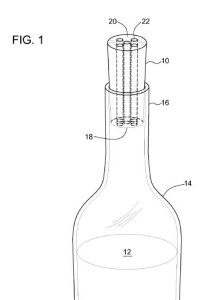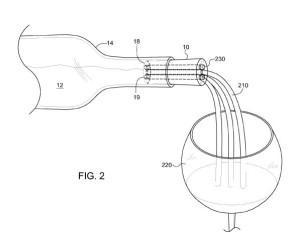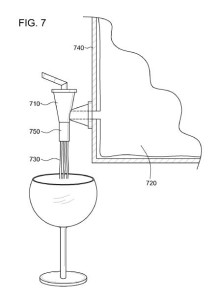“Wine Technology of the Future” is a series on The Academic Wino that features new inventions and patents that attempt to make your wine experience easier and more enjoyable. Previously on this series, we’ve introduced the “self aerating wine bottle”; the “corkscrew with integral intelligent thermometer”; and most recently the “wine dispensing and preservation device”. Today’s invention is the “multi-stream wine aerating device” created by Skip A. Lei from Portland, Oregon. The patent for this device was filed on April 14th, 2011 and the patent application was published on October 18th, 2012.
The “multi-stream wine aerating device” was invented to serve as a low-price wine aerator to allow wine to breathe prior to consuming. Many wines, particularly many red wines, need to “breathe” prior to consumption. By exposing the wine to air, it allows the wine to “open up” and show general aromatic and sensory balancing and improvement. Depending upon the wine, this process can vary quite a bit in the length of time needed for proper breathing. Younger red wines tend to require longer breathing time than older wines, as they typically have tighter tannins (i.e. a structural compound that affects the mouthfeel and other aspects of the sensory profile of the wine) and need more time to soften and mellow out.
As any wine lover knows, there are many gadgets out there to help speed along this breathing process. Regardless of the device (i.e. decanters, the Vinturi aerator, etc), the ultimate goal and function of these inventions are to increase the surface area of the wine in order to increase and maximize the amount of wine surface area that is in contact with the air. The more air contact a wine gets, the faster it can breathe, and the sooner it will be ready to drink.
The purpose of the “multi-stream aerating device” is really no different than all the other aerating and “breathing” devices in that it functions to increase the surface area of the wine in order to increase the wine-to-air ratio and allow the wine to breathe at a much faster rate than if it were just sitting in the bottle. The difference between this device and all other aerating devices is in the way it achieves this goal.
The inventor describes the device as either being a stopper (think: cork-like), a screwed on device, or fitting onto the edge of a pour spout such as with bag-in-box wines. Within the device, at least 3 tubes are embedded inside the stopper to allow wine to pass through multiple channels in a smooth fashion, and not by the “Venturi effect”.
As an aside: the “Venturi effect” functions to pull a fluid from a larger tunnel through a smaller tunnel, resulting in a vortex-like motion and significant increase in fluid speed through the tunnels. Some have found that this harsh movement on wine damaging some of the more delicate flavors and aroma on the wine.
By putting the device in/on the bottle of wine and then pouring the wine into your glass as if you were pouring the wine from the bottle without the device, the wine will split into 3 (or more) streams thereby increasing the surface area of the wine in order to maximize air contact and breathability. Each of the tunnels is a uniform diameter in order to avoid the “Venturi effect”. To get a visual of what this actually looks like, check out the accompanying figures throughout this short post!
In summary, this device should increase the wine-to-air ratio and move the wine through the tunnels in a gentle fashion such that the wine is able to “breathe” and open up much faster than if it were just sitting in the bottle. The gentle nature of the wine flowing through the tunnels, as opposed to being “pulled” through the tunnel in the so called “Venturi effect” protects the wine from the potentially damaging effect of the “raging river Venturi effect” on the delicate aromatics of the wine.
What do you all think of this aerator? Would you use this aerator instead of your current aerator (if you have one)? What would you name the device? Would you buy this device?
Please feel free to leave your comments!
Source: US Patent 20120261844 http://www.freepatentsonline.com/y2012/0261844.html




7 comments for “Wine Technology of the Future: Multi-Stream Wine Aerating Device”